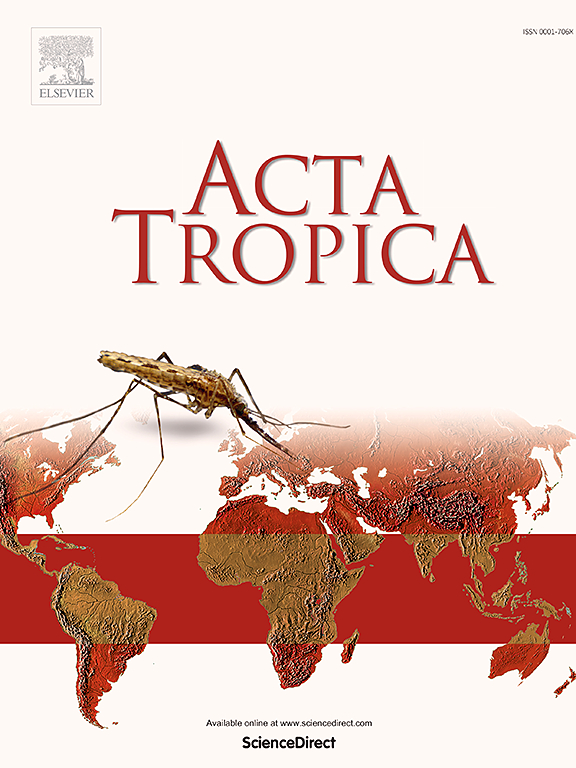A quantitative and systematic analysis of Anopheles stephensi bionomics and control approaches
IF 2.1
3区 医学
Q2 PARASITOLOGY
引用次数: 0
Abstract
Anopheles stephensi is a mosquito endemic to South Asia and the Arabian Peninsula that has recently been detected in eight African countries, posing a significant threat to global malaria control efforts. A challenge with An. stephensi is that it requires unique surveillance and control tools when compared to other malaria vectors. Through a systematic literature review, we investigated the efficacy of trapping methods and controls for An. stephensi mosquitoes, with a focus on studies of its behavior and biology. Data from 83 articles (native range: Afghanistan, India, Iran, Iraq, Pakistan, and Qatar; invasive range: Djibouti, Ethiopia, Sri Lanka, Saudi Arabia, and Sudan) met our study inclusion criteria. Data from these studies revealed that using host-seeking animal baited traps increased the number of mosquitoes collected per trap per day in the native range when compared to host-seeking human baited traps. However, these differences were not present in data collection rate assessments from the invasive range. We also found that An. stephensi equally used a large variety of breeding habitats in the native range, but that it tended to prefer water reservoirs and wastewater in the invasive range. Finally, we found that temephos, fenthion, Bacillus thuringiensis israelensis, and Beauveri bassiana were more effective at reducing larvae in their native range compared to the approaches found in our systematic literature search, but the relative effectiveness of these approaches in the invasive range was less clear. Understanding proven historical surveillance and control approaches is essential to the advancement of invasive An. stephensi mitigation efforts, but continued investigations in the invasive range are critical to reducing the impacts of malaria morbidity and mortality.
对史蒂芬按蚊生物组学和控制方法进行定量和系统分析。
史蒂芬按蚊是南亚和阿拉伯半岛流行的一种蚊子,最近在八个非洲国家发现了这种蚊子,对全球疟疾控制工作构成了重大威胁。与其他疟疾病媒相比,史蒂芬斯蚊需要独特的监测和控制工具,这是史蒂芬斯蚊面临的一个挑战。通过系统的文献回顾,我们调查了诱捕方法和控制史蒂芬斯氏疟蚊的效果,重点是对其行为和生物学的研究。原生地:阿富汗、印度、伊朗、伊拉克、巴基斯坦和卡塔尔;入侵地:吉布提、埃塞俄比亚、斯里兰卡和卡塔尔:吉布提、埃塞俄比亚、斯里兰卡、沙特阿拉伯和苏丹)符合我们的研究纳入标准。这些研究的数据显示,在原生地,使用寻找宿主的动物诱饵诱捕器与寻找宿主的人类诱饵诱捕器相比,增加了每个诱捕器每天收集的蚊子数量。然而,在入侵区的数据收集率评估中,这些差异并不存在。我们还发现,在原生地,史蒂芬斯氏疟蚊同样使用多种繁殖生境,但在入侵地,它往往更喜欢水库和废水。最后,我们发现,与系统文献检索中发现的方法相比,特灭磷、倍硫磷、苏云金芽孢杆菌(Bacillus thuringiensis israelensis)和 Beauveri bassiana 能更有效地减少原生地幼虫的数量,但这些方法在入侵地的相对效果并不明显。了解历史上行之有效的监测和控制方法对于推进雅罗氏疟原虫入侵缓解工作至关重要,但在入侵区继续开展调查对于降低疟疾发病率和死亡率的影响也至关重要。
本文章由计算机程序翻译,如有差异,请以英文原文为准。
求助全文
约1分钟内获得全文
求助全文
来源期刊

Acta tropica
医学-寄生虫学
CiteScore
5.40
自引率
11.10%
发文量
383
审稿时长
37 days
期刊介绍:
Acta Tropica, is an international journal on infectious diseases that covers public health sciences and biomedical research with particular emphasis on topics relevant to human and animal health in the tropics and the subtropics.
 求助内容:
求助内容: 应助结果提醒方式:
应助结果提醒方式:


